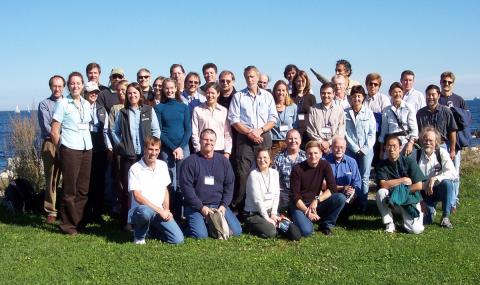Tuesday, September 26, 2006 to Thursday, September 28, 2006
Durham, New Hampshire
Meeting Goals
This workshop will occur on September 26-28, 2006, on the UNH campus (Durham, NH). The workshop will bring experts from diverse fields together with
OR&R scientists to discuss how to improve and integrate trajectory fate and effects forecasting capabilities. This workshop is by special invitation only.
Workshop discussions will include:
- Predicting Risk - Approaches and Challenges
- Forecasting Environmental Effects
- Integrating Transport and Fate Models with Environmental and Toxicological Data
- Communicating Complex Modeling to Decision Makers
- Developing Response Time-Scale Predictions that Reflect Uncertainties and Are Useful to Decision Makers
Anticipated outcomes will be: an increased collaboration between scientists and decision makers across the physical, biological, and toxicological fields of spill response and modeling; incorporation of innovations from other scientific disciplines into spill modeling; and a set of research needs that addresses improvements to spill response modeling.

Presentations
Welcome & Introductions
Amy Merten and Nancy Kinner
Workshop Structure & Outcomes
Charles Vörösmarty, Facilitator
Spill Response: Defining the Challenges (NOAA)
Debbie Payton
Population-Level Risk Assessment: Pesticides Scenario and Experiences
Wayne Munns
Integrated Modeling: A New Approach to Improved Spill Response Modeling
Joel Baker
Breakout Session: Introduction: Overall Breakout Sessions Strategy Place of Refuge
CJ Beegle-Krause
What is Integrated Modeling?
Chris Barker
Response Options and Tradeoffs: How We Do It Now
Alan Mearns
Key Physical Process: Ocean Surface Mixed Layer
Greg Chini
Integrated Assessment to Support Ecosystem Modeling and Management - currently not available
Tracy Collier
Modeling Dispersion for Decision-Makers: Dispersant Scenario - currently not available
Charlie Henry
Breakout Session: Introduction: Defining Time and Length Scales and Data Needs for Integrated Models
CJ Beegle-Krause
Workshop Participant Reading Materials
To see what an oil spill looks like, visit the NOAA OR&R website Open Water Oil Identification Job Aid
Galt, J.A. (1994) Trajectory Analysis for Oil Spills Journal of Advanced Marine Technology Conference 11, pp 91-126.
Recent paper on potential deepwater well blowout, Combining Modeling with Response in Potential Deep Well Blowout: Lessons Learned from Thunder Horse, Beegle-Krause, C.J. and W. Lynch. Accepted for IOSC 2005, May 15-19, 2005, Miami Beach, FL.
Job aid for making response decisions at the NOAA OR&R website, Characteristic Coastal Habitats: Choosing Spill Response Alternatives
Response Guides (We suggest picking one of these three)
- Oil Spills in Coral Reefs: Planning & Response Considerations
- Oil Spills in Mangroves: Planning & Response Considerations
- Oil and Sea Turtles: Biology, Planning, and Response
Historical Incidents Database
Below are three particularly interesting incidents. By searching for these incidents in the historical database, you'll pull up all the records for each incident. Click on the incident name to see the initial report link. Search results come up with the latest entries first. Tracking the situation reports will give you a timeline of the incidents. Other products such weather, trajectory and resources at risk provide updates on the environmental information.
- Incident Name: M/T Igloo Moon
- Incident Name: MV New Carissa
- Incident Name:
Seafood Issues: Guidance on Sensory Testing and Monitoring of Seafood for Presence of Petroleum Taint Following an Oil Spill. NOAA Technical Memorandum, NOS OR&R 9.
Questions? Please contact kathy.mandsager@unh.edu (603.862.1545)